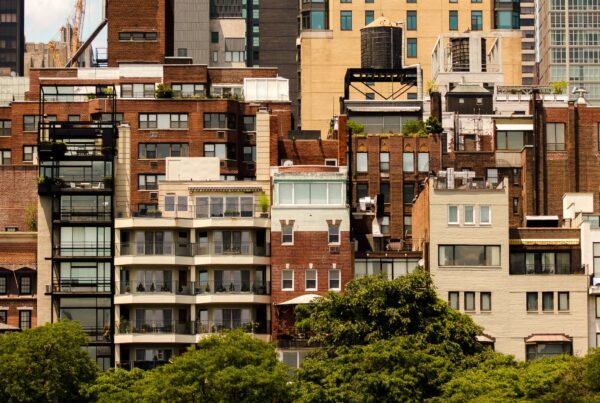Will Less Supply Bring Rent Growth in 2020 for NYC?
02/20/2020
The rental market in NYC is changing. This year, we will witness a 59% reduction in the amount of new rental supply delivered into the market compared with 2019. This is a 69% reduction compared to 2018! I recently sat down with Jordan Sachs and Chelsea Werner of BOLD New York to talk about these changes and the overall outlook for New York City’s rental market in 2020 (you can listen to our full conversation here).
After the disruption that 2019 rent reform caused, multifamily owners will be pleased to know that 2020 might bring some positive changes.
Increased Demand = Increased Rent
From 2015-2019, rents were flat or decreasing in New York City. However, one of the biggest implications of the 2019 rent laws is owners can no longer convert rent-stabilized units into free-market units. This will continue to reduce housing supply across the city.
With restricted supply, rents are predicted to rise for available units in 2020. You may have noticed that this has already started. In November 2019, rents in Manhattan, Brooklyn, and Queens increased, inventory decreased, and concessions declined for the eighth month in a row.
Much of this is also due to increased rental demand as new job growth attracts young renters to New York. The growing tech community is made of upwardly mobile, 25- to 35-year-olds with a higher propensity to rent (the average tech salary in NYC is around $100,000). As the tech population grows, and as companies like Google, Amazon, and Facebook bring more jobs to the city, I predict rent prices and demand will continue to increase in 2020.
New Supply Falls off a Cliff
Perhaps the biggest impact on the rental market, besides the rent reform act, is the massive drop in new construction inventory. After several years of significantly increased deliveries, (with many years delivering over 20,000 units), there are only 6,858 units scheduled to deliver in all NYC in 2020. To give you context, that number is significantly lower than many other smaller metro areas in the US.
As we look ahead to 2021 and 2022 the new supply is constrained even further. Interestingly, only 13% of the new units delivered this year will be in Manhattan.
How is Rental Demand Evolving?
Today, renters can take advantage of services like Via, Uber, and WeWork, so their living options are vastly increased geographically. They can choose between a trendy neighborhood, proximity to their jobs, or living wherever they get the lowest rent because all other neighborhoods are an Uber away.
Brooklyn continues to be a by-choice market, versus a by-necessity option, as residents choose to be there for social reasons over saving money. That expansion has created value options for renters in many Manhattan submarkets. Jordan says, many downtown renters have moved north because units are larger at lower prices. He’s seen a significant amount of growth north of 100th Street, in Washington Heights, in West Harlem, and into Inwood.
In higher-end markets, such as the West Village, this year may mark a turning point for those markets, as limited new supply could force rents to recover. We are also seeing increased interest in east side markets, like Essex Crossing, the Lower East Side, and Two Bridges. As new developments in these neighborhoods stabilize, they will improve the reputation and rental rates for each neighborhood.
Concessions Are Disappearing in 2020
Some investors who bought property between 2013-2017 realized they won’t achieve their high rental pro-formas. Many new buyers had to reevaluate their investment strategy and offer rent concessions to maintain rents and occupancy.
Rent concessions give the tenant one or two months of free rent for signing a lease. The other type of concession landlords have offered is the OP (Owner Paid) concession, meaning the owner pays the tenant’s broker fee and may even include other perks, like a free parking spot or gift card.
As demand increased in 2019, concessions from previous years began to disappear. Now, owners can adjust their strategy to one of rental growth. My advice is to never offer more than a two month concession. If you offer more, your income stream’s validity will be questioned at points of refinancing or sale.
What’s the Catch?
While the proof about market rents increasing will show in late spring and early summer, you may be reading this wondering….. “what’s the catch?”
Its, no surprise that in NYC the risk is primarily political. Owners of free-market units are advised to watch the “Good Cause” Eviction bill that’s making its way through the state government. As it’s currently written, this bill would limit owners’ abilities to raise rents beyond dictated levels and achieve market rent. I recently spoke about this at length in a podcast with Jay Martin. NYC multifamily owners must become more politically active at the local level if they want their voices heard.
I look forward to your comments and feedback on this topic as 2020 unfolds
facebook LinkedIn Instagram Twitter [ctt link=”e06se” template=”1″]Sellers have decided to move to market now, in 2017.[/ctt]





Peter as a longtime rental property owner, building manager and licensed beoker for moreff than thirty five years i have never been more discouraged.
NY state has quickly become the most progressive government run housing industry in the nation.
Private investment will continue to flee the local
economy and we will become the laughing stock of i told you so economies.
Political change cannot come quick enough.
Unfortunately the horizon looks less than promising on that front as well
I enjoy your posts nonetheless.
Please continue to provide the valuable research.